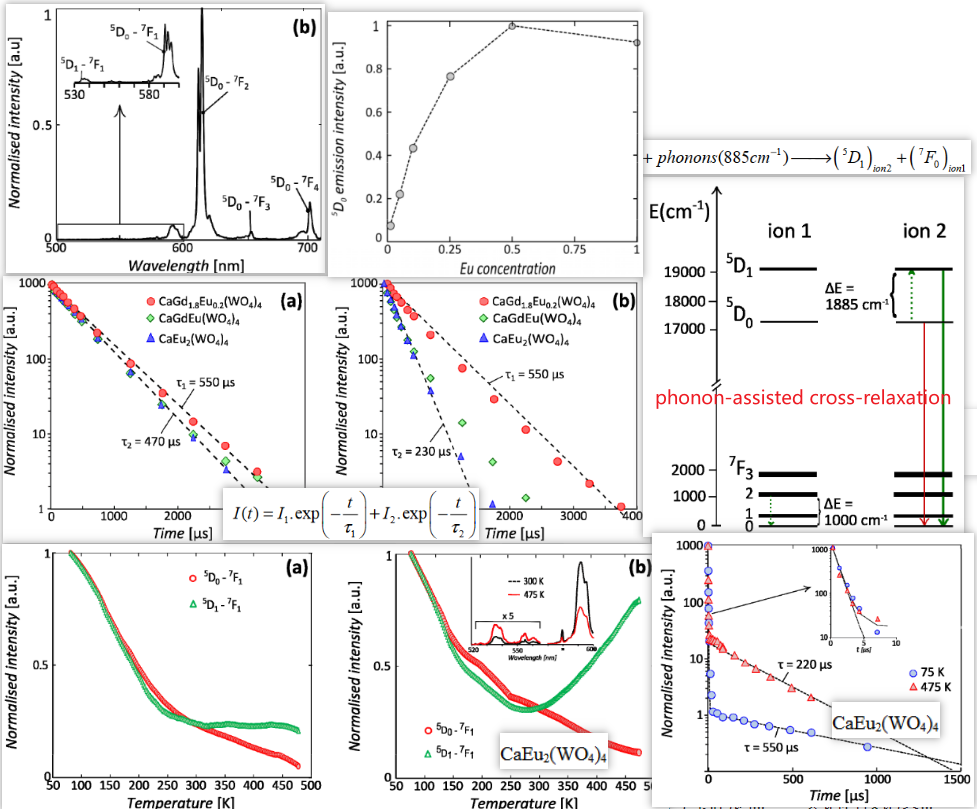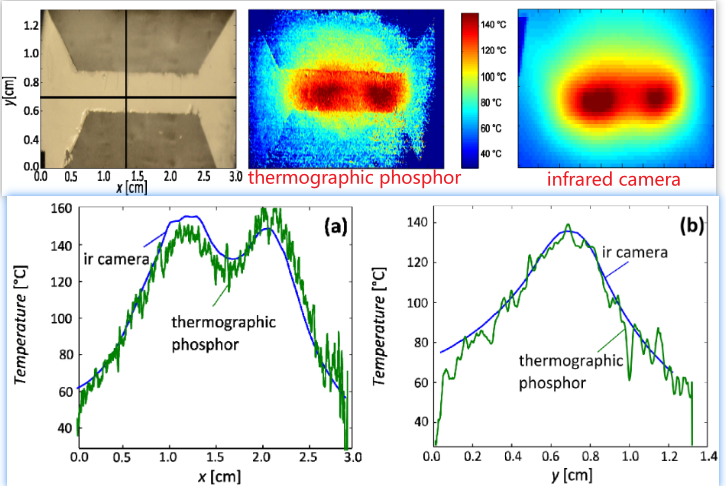稀土温度传感
Energy transfer in Eu3+ doped scheelites: use as thermographic phosphor-OE-2014
最早提到利用荧光粉做温度探测的是在1937年,实际应用是在1950s,当时荧光粉was painted on the wing surfaces of a wind-tunnel model。温度传感可以基于不同的response mode,其中三个重要的是:
- relative intensities of emission peaks;
- changes in decay time;
- shifts in peak position.
之前研究基于intensity ratios的离子主要是Dy3+和Sm3+,虽然Eu3+也有报道(在Y2O2S中),但是和温度的依赖性不强。这篇文章讨论的是scheelite白钨矿材料中Eu3+的5D0 and 5D1的intensity ratios随温度的变化,这种依赖关系可以用phonon-assisted cross-relaxation process而不是thermalisation来解释。
CaGd2(1-x)Eu2x(WO4)4,激发谱有313 nm的Gd3+的信号,但是没有Gd3+的发光,因为重新收和向Eu3+的能量传递,x = 0.5时才表现出明显的浓度猝灭。Eu掺杂浓度比较低的时候,不同Eu离子之间的平均距离比较大,因此Eu-Eu之间能量传递的概率比较小。Gd3+可以认为是在可见光区optically silent,因此在低浓度掺杂的时候,Eu3+可以看作是isolated center。高掺杂浓度下会有不同Eu3+之间的能量传递。有趣的是,we can consistently fit the thermal behavior of the decay for different dopant concentrations with only two types of Eu ions (i.e. isolated ones and those showing energy transfer). (1) 低浓度掺杂Eu2+的样品,室温下的发光只有75 K时发光强度的四分之一,但是对应的寿命并没有变化。一般来说,thermal quenching is accompanied by a faster luminescence decay, due to an increase in non-radiative depopulation of the excited states. 这里显示的矛盾可能和不同温度下的吸收强度有关。
(1) 低浓度掺杂Eu2+的样品,室温下的发光只有75 K时发光强度的四分之一,但是对应的寿命并没有变化。一般来说,thermal quenching is accompanied by a faster luminescence decay, due to an increase in non-radiative depopulation of the excited states. 这里显示的矛盾可能和不同温度下的吸收强度有关。
(2) 高浓度掺杂Eu2+的样品CaEu2(WO4)4, 5D1的强度从室温开始,随温度升高而增强,因此it is expected that energy transfer mechanisms play a role。
(3) CaEu2(WO4)4的寿命存在一个temperature independent component以及一个temperature dependent slow component。5D1的寿命比5D0快,因为non-radiative depopulation of the higher excited state, e.g. by phonon relaxation or cross-relaxation processes。该样品的5D1慢衰过程对应的寿命和5D0的寿命很像,作者说这是一个a clear correspondence。作者计算了5D1慢衰过程的fraction,发现随着温度的升高,比例越来越大,This points to an increased feeding of the 5D1 level from the 5D0 level upon increasing temperature for CaEu2(WO4)4, by an energy transfer process.
(4) 低浓度掺杂Eu2+的样品,(3)中说的feeding太弱了,观察不到。
(5) thermal quenching和decay profiles都表现出了浓度依赖的cross-relaxation process, rather than a simple thermalisation process where the energy difference to populate the 5D1 level from the 5D0 level is fully covered by phonons。
(6) 别人在GdVO4基质中观察到了thermal quenching,thermalisation from the lowest to the highest excited level, leading to a thermal barrier of about 1500cm−1。但是这个无法解释作者这里观察到的浓度依赖的特性。
(7) 上图中的交叉弛豫需要885 cm-1的声子能量,5D1和5D0能级thermally coupled。

Dual-Emitting Nanoscale Temperature Sensors-CM-2015
Er3+-doped BaTiO3 nanocrystals for thermometry: Influence of nanoenvironment on the sensitivity of a fluorescence based temperature sensor.
Luminescence nanothermometry-Nanoscale-2012
光纤拉曼温度传感
红外测温仪
参考资料:
(1) 谈谈红外测温仪-姬扬-科学网
(2) 再谈红外测温仪-姬扬-科学网